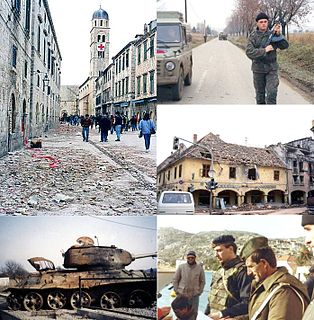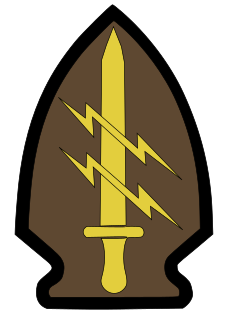Related Research Articles

The Croatian Army and Croatian Ground Army is the largest and most significant component of the Croatian Armed Forces (CAF).

Yugoslav Radio Television (JRT/ЈРТ) was the national public broadcasting system in the SFR Yugoslavia. It consisted of eight subnational radio and television broadcast centers with each one headquartered in one of the six constituent republics and two autonomous provinces of Yugoslavia.

Croatian Railways is the national railway company of Croatia. Croatia is a member of the International Union of Railways (UIC). The UIC Country Code for Croatia is 78. The Croatian rail network carried 20.270 million passengers in 2018.
The subdivisions of Croatia on the first level are the 20 counties and one city-county.

The Battle of the Barracks was a series of engagements that occurred in mid-to-late 1991 between the Croatian National Guard and the Croatian police on one side and the Yugoslav People's Army (JNA) on the other. The battle took place around numerous JNA posts in Croatia, starting when Croatian forces blockaded the JNA barracks, weapons storage depots and other facilities. It formally began on 14 September; its objective was to neutralise the JNA positions in ZNG-held territory and to secure arms and ammunition supplies for the poorly equipped ZNG.

Matica hrvatska is the oldest independent, non-profit and non-governmental Croatian national institution. It was founded on February 2, 1842 by the Croatian Count Janko Drašković and other prominent members of the Illyrian movement during the Croatian National Revival (1835–1874). Its main goals are to promote Croatian national and cultural identity in the fields of art, science, spiritual creativity, economy and public life as well as to care for social development of Croatia.
Konzum is Croatia's largest supermarket chain, with just over 700 stores open in Croatia and more than 10,000 employees.
The subdivisions of the Kingdom of Yugoslavia existed successively in three different forms. From 1918 to 1922, the kingdom maintained the pre-World War I subdivisions of Yugoslavia's predecessor states. In 1922, the state was divided into 33 oblasts or provinces and, in 1929, a new system of nine banates was implemented.

The Royal Croatian Home Guard was the Croatian-Slavonian army section of the Royal Hungarian Landwehr, which existed from 1868 to 1918. The force was created by decree of the Croatian Parliament on December 5, 1868 as a result of the Croatian–Hungarian Settlement.

The 1991 Yugoslav campaign in Croatia was a series of engagements between the Yugoslav People's Army (JNA), the Yugoslav Navy and the Yugoslav Air Force, and the Croatian National Guard (ZNG) then the Croatian Army (HV) during the Croatian War of Independence. The JNA was originally deployed in order to preserve Yugoslavia, and the initial plan of the campaign entailed the military occupation of Croatia and the removal of the Croatian leadership elected in 1990. The JNA intervention was the culmination of its involvement in the confiscation of weapons from Croatia's Territorial Defence, and in the Croatian Serb revolt that had begun in August 1990. From that time, the JNA had been frequently deployed to form a buffer zone between the insurgents and the ZNG or the Croatian police. In effect, these JNA buffer zones often secured the territorial gains of the insurgents and led to an increasingly hostile relationship between the JNA and Croatia. The JNA campaign plan was amended shortly before the campaign to include the relief of JNA barracks besieged by the ZNG. The besieging and subsequent capture of several JNA facilities allowed Croatia to arm its previously poorly equipped military and to equip new recruits.
The Varaždin–Dalj railway, officially designated as the R202 railway, is a 249.839-kilometre (155.243 mi) long railway line in Croatia that spanning between the city of Varaždin and the town of Dalj east of Osijek. It is non-electrified and mostly single-tracked.

The order of battle of the Croatian Special Police Units in 1991–1995 included up to 30 individual special forces units subordinated to the Ministry of the Interior. The special police was created around the Ministry of the Interior's existing airborne special forces unit following an open revolt of the Croatian Serbs against the Government of Croatia in August 1990. It further developed with the increasing involvement of the Yugoslav People's Army in the conflict, supporting the Croatian Serbs. The conflict escalated into the Croatian War of Independence in 1991. The special police took part in the first clashes of the war in Pakrac and at the Plitvice Lakes. As Croatia had no army, the 3,000-strong special forces became the country's most effective fighting force.
References
- ↑ Ostroški, Ljiljana, ed. (December 2013). Statistički ljetopis Republike Hrvatske 2013 [2013 Statistical Yearbook of the Republic of Croatia](PDF). Statistical Yearbook of the Republic of Croatia (in Croatian and English). Vol. 45. Zagreb: Croatian Bureau of Statistics. p. 529. ISSN 1334-0638 . Retrieved 17 February 2014.